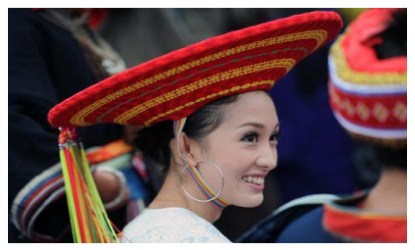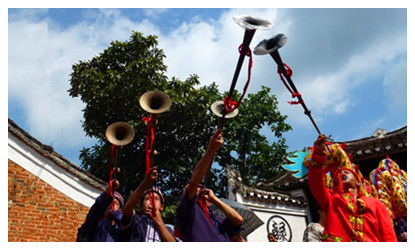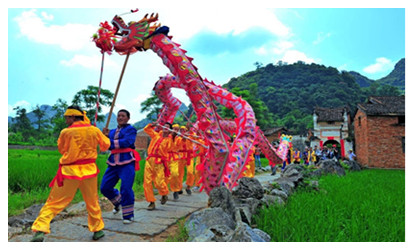Yao ethnic minority, with a population of 704,564, is mainly scattered throughout mountainous areas between the Hunan, Guangxi, and Guangdong boundaries. Historically, the Yaos have had at least 30 names including

Panyao, Shanziyao, Guoshanyao, Pindiyao, Baikuyao, etc., each based on their ways of production, lifestyles, dresses, and adornments. The name "Yao" was officially adopted after the founding of the People's Republic in 1949.
Living Quarters of Yao Minority
The typical house of the Yao is a rectangular wood-and-bamboo structure, usually with three rooms; the sitting room, in the middle; and bedrooms, on both sides. A cooking stove is set in a corner of each bedroom. Some hillside houses are two-storied, the upper story being the sitting room and bedrooms, the lower being stables.
Rice, corn, sweet potatoes, and taro are the staple foods of the Yao. Common vegetables include peppers,

pumpkins, and soybeans. Alcoholic drinks and tobacco are also quite popular. A favorite dish of the Yao is "pickled fish". The cleaned fish is blended with salt and rice flour, then sealed in airtight pots. Beef, mutton, and other meat are also pickled this way, and are considered a banquet delicacy. The Yao people also love to drink tea. A daily necessity of the Yao is "oil tea". The tealeaves are fried in oil, then boiled into a thick, salty soup, and mixed with puffed rice or soybeans. The oil tea even serves to entertain visitors, on some occasions.
Dressing and Clothing
Yao have such unique styles of dress, that various communities are often quite different from one another. The ancient Yao preferred "five-colored clothes". In modern times, Yao costumes still maintain their diversity. Men wear jackets buttoned in the middle or to the left, and usually belted. Some men like trousers long enough to touch their insteps, although others prefer shorts akin to knee breeches. Men's dress is mainly in blue or black. Women's dress varies more. Some Yao women fancy short collarless jackets, and cloth belts and skirts, either long or short. Some choose knee-length jackets buttoned in the middle, belts with both ends drooping, and either long or short slacks; some have their collars, sleeves, and trouser legs embroidered with beautiful patterns. In addition to the silver medals decorating their jackets, many Yao women wear silver bracelets, earrings, necklets, and hairpins.
Festivals of Yao
Festivals take place one after another, in Yao communities, at a frequency of about once a month. The Yao share some festivals, such as the Spring Festival, the Qingming Festival, the Dragon Boat Festival, and the Mid-Autumn Festival, with the Han Chinese. In addition, the Yaos have their own festivals, for instance, the Land God Festival, the Pure Brightness Festival, the Danu Festival, and the Shuagetang Festival. During festivals, Yao communities hold lavish rites, to offer sacrifices to their ancestors.
Customs of Yao
The Yao practice an interesting, primitive cooperation called "singing-while-digging". While the group is working, a young man stands out in the fields, beating a drum and leading the singing. Everyone sings after him.
The Yaos have intriguing marriage customs. With antiphonal singing as a major means of courting, youngsters choose lovers by themselves, and get married with the consent of the parents on both sides. However, the bridegroom's family must pay a sizeable amount of silver dollars and pork, as betrothal gifts to the bride's family.
The Yao people have a religion which is based on medieval Chinese Taoism, although many have converted to Buddhism, and some to Christianity. Though some have converted to other religions, many still practice their traditions, and worship gods, nature, and their ancestors. Their belief in "Panhu", the dog spirit, reveals a vestige of totemism.
Folk Culture & Art
Most Yaos live in beautiful, humid mountain valleys, which are densely covered with pines, Chinese firs, tea bushes, etc., and teeming with wild animals. Natural resources are rich there.
 The ethnic minority has its own language, which belongs to the Yao Austronesia of Chinese-Tibetan Phylum. As a result of close contacts with the Han and Zhuang people, many Yaos are also familiar with the Han and Zhuang languages. The Yao people have no written language of their own, so they usually use written Chinese.
The ethnic minority has its own language, which belongs to the Yao Austronesia of Chinese-Tibetan Phylum. As a result of close contacts with the Han and Zhuang people, many Yaos are also familiar with the Han and Zhuang languages. The Yao people have no written language of their own, so they usually use written Chinese.
The
Yaos cherish a magnificent oral literary tradition. Singing also forms an indispensable part of their lives. Their traditional instruments include drums, gongs, the suona horn (a woodwind instrument), and the long waist drum, which is unique to the Yaos. The revived waist drum dance has been frequently performed, both in
China and abroad, since the 1950s. The Yaos are expert at weaving, dyeing, and embroidery, and the products made by them have become famous all over the country.
 Panyao, Shanziyao, Guoshanyao, Pindiyao, Baikuyao, etc., each based on their ways of production, lifestyles, dresses, and adornments. The name "Yao" was officially adopted after the founding of the People's Republic in 1949.
Panyao, Shanziyao, Guoshanyao, Pindiyao, Baikuyao, etc., each based on their ways of production, lifestyles, dresses, and adornments. The name "Yao" was officially adopted after the founding of the People's Republic in 1949.
 pumpkins, and soybeans. Alcoholic drinks and tobacco are also quite popular. A favorite dish of the Yao is "pickled fish". The cleaned fish is blended with salt and rice flour, then sealed in airtight pots. Beef, mutton, and other meat are also pickled this way, and are considered a banquet delicacy. The Yao people also love to drink tea. A daily necessity of the Yao is "oil tea". The tealeaves are fried in oil, then boiled into a thick, salty soup, and mixed with puffed rice or soybeans. The oil tea even serves to entertain visitors, on some occasions.
pumpkins, and soybeans. Alcoholic drinks and tobacco are also quite popular. A favorite dish of the Yao is "pickled fish". The cleaned fish is blended with salt and rice flour, then sealed in airtight pots. Beef, mutton, and other meat are also pickled this way, and are considered a banquet delicacy. The Yao people also love to drink tea. A daily necessity of the Yao is "oil tea". The tealeaves are fried in oil, then boiled into a thick, salty soup, and mixed with puffed rice or soybeans. The oil tea even serves to entertain visitors, on some occasions.
 The ethnic minority has its own language, which belongs to the Yao Austronesia of Chinese-Tibetan Phylum. As a result of close contacts with the Han and Zhuang people, many Yaos are also familiar with the Han and Zhuang languages. The Yao people have no written language of their own, so they usually use written Chinese.
The ethnic minority has its own language, which belongs to the Yao Austronesia of Chinese-Tibetan Phylum. As a result of close contacts with the Han and Zhuang people, many Yaos are also familiar with the Han and Zhuang languages. The Yao people have no written language of their own, so they usually use written Chinese. Ask Questions ?
Ask Questions ?